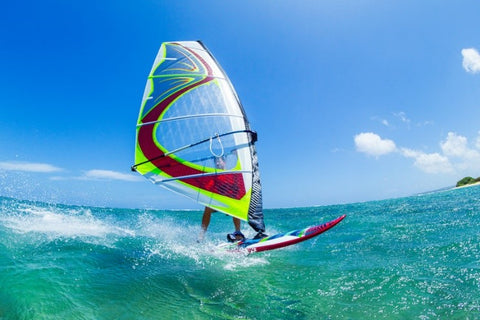The Pros and Cons of Windsurfing on Inflatable SUP Boards
Windsurfing, or sailboarding is making a comeback. Wider boards make it safer for people to learn the skill today, and many people get a quick start by taking a lesson or two. In fact, It only takes about 2 weeks to get proficient in windsurfing. For the adventure junkies, the addition of foils is adding new and awesome challenges. And now, it’s possible to have convenience and portability with an inflatable Windsurf Board.
But will an inflatable windsurf board work for you?
Read on to understand the differences between the two types of boards so you can choose the type of windsurfing SUP that will keep you coming back for more sailing!

What is an Inflatable SUP and how is it Different from a Hardshell Board?
Inflatables have pretty much become the standard for surfers looking for paddleboarding and windsurfing equipment - particularly at the entry level. They are usually made from a combination of PVC plastic layers and woven fibers interlinked through the top and bottom parts of the board. They provide excellent stiffness and durability. Not to mention that the price point is much lower.

Sizes can range based on the height and weight of the user, the weight of the board also varies from around 18 to 30 pounds. They take little time to inflate. Most pumps today are duo purpose inflating and deflating which is super convenient.
Most inflatables can be incredibly rigid upon inflation. While they come with built-in fins, most models also provide replaceable fin options. In fact, most manufacturers utilize a universal fin that fits almost all boards.
Hardshell boards, on the other hand, are usually constructed from materials like wood, kevlar, foam, and fiberglass, all protected with several epoxy resin coats. At its core, the foam allows for buoyancy while the other materials make the board rigid and durable. The final epoxy coating at the surface gives the board its watertight quality.

Paddleboards also make excellent alternatives (so long as you install a sail). The sail is held in place with a slot on the board to which the mast base is connected. Make sure your inflatable SUP is Windsurf ready with a slot for the sail. In addition, the fact that one can windsurf and paddleboard on the same inflatable, with minimal adjustments required, is a bonus. Top Windsurfing companies like Naish now offer boards that are versatile meaning you can
SUP or Windsurf or even Wingsurf on them.

Windsurfing on an Inflatable SUP: Pros and Cons
With that, let’s head straight to the pros and cons of choosing an inflatable SUP windsurfing board.
Pros:
- Inflatable SUPs are generally cheaper than their hardshell counterparts, starting at around the $700 mark. Traditional windsurf boards start around $900 and go all the way as high as $4000.
- They are easy to transport and store when deflated. Most models are shipped with a carrying case in the form of an extra-large backpack. iSUPs can also be checked into most airports globally which, in itself, is a compelling reason to buy them.
- Inflatables have been proven to be more durable than hardshell (epoxy) SUPs in the long run - and are less susceptible to the holes and dings from hitting things in the water. The best ones are crafted from military-grade materials that even when damaged, won’t involve expensive repairs.
- It cannot be stressed enough the edge that is given to iSUPs by their storage and space savings. A small closet can easily house a fleet of inflatables (in their deflated state), while only providing space for only a handful of hardshell boards. Also, since they’re composed mostly of air and plastic, iSUPs are considerably lighter.

- The softer deck on iSUPs reduces fatigue.
- Impact to the rider when falling doesn’t hurt as much as on a hardshell board. The user’s feet are more relaxed (akin to standing on a rubber mat) and, thus, there’s reduced contact pressure.
- iSUPs are enjoying a wave of innovation bringing them close to the rigidity and precision levels of hardboards while maintaining all of their distinctive advantages.
Cons:
- They are less precise than hardshell boards, especially when it comes to downwind runs.
- Since they’re less structurally rigid, manufacturers are unable to replicate the precision levels and higher-performance ergonomics to be had in hardshell SUPs.
- Inflatables do not really excel in “professional” or competitive usage scenarios, yet.
In Closing
Let’s face it, most people that consider buying a stand-up paddleboard are probably best served going with the inflatable option. They may not have the fancy customization possibilities or the precision of their hardshell counterparts, but a myriad of other advantages compensate.
iSUPs are cheaper, more versatile, and more portable than hardshell SUPs. They are also easier to set up and generally provide a more comfortable surface for the user. They can also survive being whipped around in a wider range of settings than hardshell boards. While the inflatable option is the better fit for most, those with niche needs like racing - and have the budget to match - could be better served on a hardboard.
In essence, it all comes down to personal preference. The important thing is to be on the water with great equipment you can trust and friends who love the sport as much as you do.

